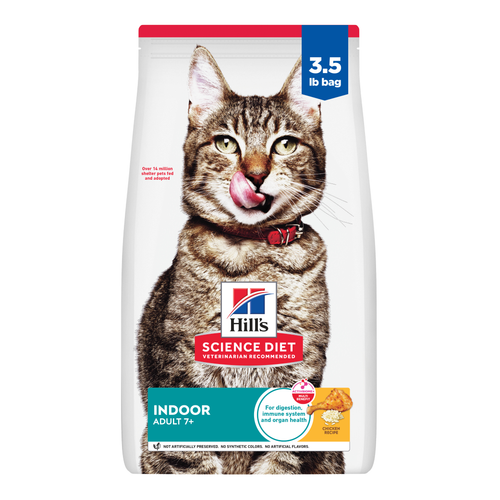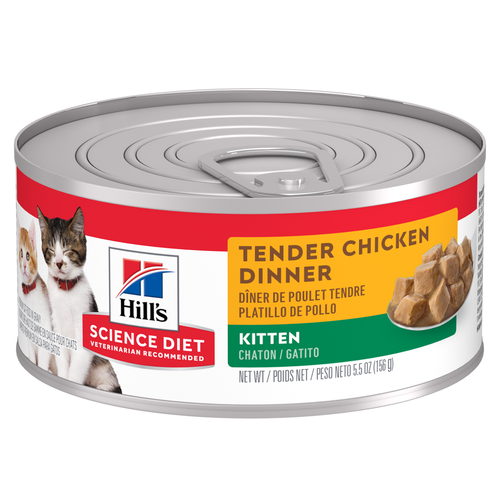
-
Find the right food for your petTake this quiz to see which food may be the best for your furry friend.Find the right food for your petTake this quiz to see which food may be the best for your furry friend.Featured products
 Adult Large Breed Chicken & Barley Recipe Dog Food
Adult Large Breed Chicken & Barley Recipe Dog FoodSupports healthy joints, lean muscle, and beautiful coat for large breed dogs
Shop Now Hill's Science Diet Adult Chicken & Beef Entrée Dog Food
Hill's Science Diet Adult Chicken & Beef Entrée Dog FoodChicken & Beef Entrée in a delicious loaf with complete & balanced nutrition to help keep adult dogs active and healthy
Shop Now Adult Chicken & Barley Recipe Dog Food
Adult Chicken & Barley Recipe Dog FoodSupports lean muscle and beautiful coat for adult dogs
Shop NowFeatured products Adult Turkey & Liver Entrée Cat Food
Adult Turkey & Liver Entrée Cat FoodPrecisely balanced nutrition with the delicious taste of minced turkey & liver to help fuel the energy needs of cats during the prime of their life
Shop Now Senior Vitality Adult 7+ Tuna & Vegetables Stew
Senior Vitality Adult 7+ Tuna & Vegetables StewImproves Everyday Ability to Get Up & Go
Shop Now Adult 7+ Indoor Chicken Recipe Cat Food
Adult 7+ Indoor Chicken Recipe Cat FoodSupports energy level and beautiful fur in mature indoor cats
Shop Now -
Dog
- Dog Tips & Articles
-
Health Category
- Weight
- Food & Environmental Sensitivities
- Urinary
- Digestive
- Joint
- Kidney
-
Life Stage
- Puppy Nutrition
- Adult Nutrition
- Senior Nutrition
Cat- Cat Tips & Articles
-
Health Category
- Weight
- Skin & Food Sensitivities
- Urinary
- Digestive
- Kidney
-
Life Stage
- Kitten Nutrition
- Adult Nutrition
Featured articles What Is Littermate Syndrome? Pet Adoption Guide
What Is Littermate Syndrome? Pet Adoption GuideLearn more about littermate syndrome in dogs and cats and how to successfully navigate adoption and early socialization processes.
Read More How to Properly Mix Wet & Dry Pet Foods
How to Properly Mix Wet & Dry Pet FoodsAn Orange cat eating from a bowl filled with mixed food
Read More The Science Behind Our Love for Pets
The Science Behind Our Love for PetsLearn the scientific reasons why we have such strong connections with our pets, and what science says about the love between humans and our furry friends.
Read More -


If your cat repeatedly has problems urinating, your veterinarian may recommend your cat get a perineal urethrostomy. Here's everything you need to know about PU surgery in cats and how it could help get their urinary system back on track.
Why Would My Cat Need a Perineal Urethrostomy?
Urinary blockages are a fairly common problem in cats, especially among male cats. A blockage can be caused by a lower urinary tract disease that leads to inflammation and swelling in the urethra, the tube that allow urine to pass from the bladder to outside the body. Stones, mucus plugs or tumors in the urethra can also cause blockages. If a cat can't urinate, their bladder swells up with urine. Not only is this extremely painful, but cats with urinary blockages are at risk of life-threatening damage to their bladder, kidneys and the rest of the body.
Most times, urinary blockages can be managed through a combination of a balanced meal plan, medicine, stress reduction, increased water consumption and/or the insertion of an emergency catheter. If your cat consistently has urinary blockages that can't be managed medically, however, they may be a candidate for PU surgery.
What Is PU Surgery in Cats?
PU surgery involves surgically opening the urethra and making a new, wider opening for the cat to pee from. It's a fairly simple procedure that has been performed for many years and has a good success rate. The surgery is done under general anesthesia, usually with a local nerve block, meaning your cat will be completely asleep during the surgery and pain-free during and after the procedure.
Potential Complications
Even though PU surgery in cats is successfully performed every day, complications can happen. Potential complications after surgery include the narrowing of the urethrostomy site, urine leakage under the skin, bleeding, urinary tract infections and incontinence, which is why it is so important to have this procedure done by an experienced surgeon and properly care for your cat after the surgery.
Another important fact to consider is that your cat's urinary problems can be due to an underlying disease, such as feline lower urinary tract disease. If the underlying condition isn't addressed, your cat may continue to strain while urinating, have bloody urine and/or pee outside the litter box — even after PU surgery.

Alternative Treatments
Transpelvic urethrostomy (TPU) is an alternative to PU. However, because PU is so successful, TPU is less common.
Nonsurgical treatment requires you to work closely with your vet to try and resolve the underlying cause of your cat's urinary blockages and to monitor your cat closely for signs of urinary obstruction. Unless you're watching your cat 24 hours a day, however, this is nearly impossible. There are few alternatives for cats who repeatedly develop blockages.


Tasty Tips
Caring for a Cat After PU Surgery
To ensure your cat heals properly after their operation, follow these steps:
- Keep them indoors for several weeks following surgery.
- Monitor their surgical site daily for signs of infection. Mild swelling is normal, but major swelling, odor, heat, pain and colored discharge are all signs of infection and require a vet's attention.
- Make sure your cat urinates at least once daily. If they don't, call your vet.
- Have them wear an Elizabethan collar at all times until your vet says you can remove it. If your cat chews out the sutures, they may have to return to surgery.
- Give your cat all medicines as prescribed.
- Feed your cat canned food in addition to dry food to increase their water consumption. Your veterinarian may also recommend feeding your cat a therapeutic food that helps with your cats urinary health.
- If your vet sends you home with special litter, use it. Otherwise, if litter gets stuck to the surgical site, wipe it off with a moistened washcloth.
Most cats are fully recovered by the time they have their sutures removed — generally 10 to 14 days after the procedure. Sedation may be required to remove the sutures, so don't feed your cat before the appointment.
Most cats do very well with PU and go on to live long, healthy lives free of pain and obstruction. If PU is recommended for your cat, get all the facts you can and make sure you feel comfortable with your surgeon. Don't hesitate to ask questions — remember that you are your cat's main health advocate!


Dr. Sarah Wooten graduated from UC Davis School of Veterinary Medicine in 2002. A member of the American Society of Veterinary Journalists, Dr. Wooten divides her professional time between small animal practice in Greeley, Colorado, public speaking on associate issues, leadership, and client communication, and writing. She enjoys camping with her family, skiing, SCUBA, and participating in triathlons.
Related products

Supports energy level and beautiful fur in mature indoor cats

Improves Everyday Ability to Get Up & Go

Precisely balanced nutrition with the delicious taste of minced turkey & liver to help fuel the energy needs of cats during the prime of their life

Delectable chunks with tender chicken smothered in a rich gravy
Related articles

Discover how to train your cat, starting with very basic first steps that both reward good behavior and discourage the bad.

Learn how to litter train a kitten with this guide to potty training, including when to start litter training kittens and troubleshooting tips.

Discover which cat toys games your feline friend might like, and how they are great sources of exercise. Explore our library of articles to learn more.

When you adopt a cat, you don't just gain a best friend; you also save her life. Here's why getting a cat from a local animal shelter makes so much sense.

Put your cat on a diet without them knowing
Our low calorie formula helps you control your cat's weight. It's packed with high-quality protein for building lean muscles, and made with purposeful ingredients for a flavorful, nutritious meal. Clinically proven antioxidants, Vitamin C+E, help promote a healthy immune system.
Put your cat on a diet without them knowing
Our low calorie formula helps you control your cat's weight. It's packed with high-quality protein for building lean muscles, and made with purposeful ingredients for a flavorful, nutritious meal. Clinically proven antioxidants, Vitamin C+E, help promote a healthy immune system.

